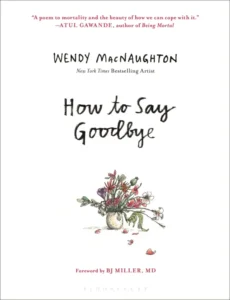How to Say Goodbye: An Illustrated Field Guide to Accompanying a Loved One at the End of Life
INSPIRATIONAL, 21 Aug 2023
Maria Popova | The Marginalian – TRANSCEND Media Service
 “Death is our friend precisely because it brings us into absolute and passionate presence with all that is here, that is natural, that is love,” Rilke wrote while ailing with leukemia. To comprehend the luckiness of death is to comprehend life itself. When a loved one is dying and we get to be by their side, it is a double luckiness — lucky that we got to have the love at all, and lucky, which is not everyone’s luck, that we get to say goodbye. Even so, accompanying a loved one as they exit life is one of the most difficult and demanding experiences you could have.
“Death is our friend precisely because it brings us into absolute and passionate presence with all that is here, that is natural, that is love,” Rilke wrote while ailing with leukemia. To comprehend the luckiness of death is to comprehend life itself. When a loved one is dying and we get to be by their side, it is a double luckiness — lucky that we got to have the love at all, and lucky, which is not everyone’s luck, that we get to say goodbye. Even so, accompanying a loved one as they exit life is one of the most difficult and demanding experiences you could have.
How to move through it is what my talented friend and sometime-collaborator Wendy MacNaughton explores in How to Say Goodbye (public library) — a tender illustrated field guide to being present with and for what Alice James called “the most supremely interesting moment in life,” drawing on Wendy’s time as artist-in-residence at the Zen Hospice Project in San Francisco and her own profound experience at her beloved aunt’s deathbed.
Punctuating Wendy’s signature ink-and-watercolor illustrations of Zen Hospice residents and her soulful pencil sketches of her aunt are spare words relaying the wisdom of hospice caregivers: what to say, how to listen, how to show up, how to stay present with both the experience of the dying and your own.
The book’s beating heart is an invitation to grow comfortable with change, with uncertainty, with vulnerability, radiating a living affirmation of the great Zen teacher Thich Nhat Hanh’s insistence that “when you love someone, the best thing you can offer that person is your presence.”
If you don’t know what to say, start by saying that.
That’s very vulnerable.
So much falling away. The body falling apart.
There’s a lot going on in that conversation.
It’s current.
Right here.
Right now.
Neither of you knows what to do in this situation.
That opens things up.
In lovely symmetry to Zen Hospice Project founder Frank Ostaseski’s five invitations for the end of life, Wendy draws on what she learned from caregivers and distills the five most powerful things we can say to the loved one dying — “a framework for a conversation of love, respect, and closure,” rendered in words of great depth and great simplicity, like the language of children, for it is this realm of unselfconscious candor we return to at the end:
I forgive you.
Please forgive me.
Thank you.
I love you.
Goodbye.
Emanating from these tender pages is a reminder that death merely magnifies the fundamental fact of living: We are fragile motes of matter in the impartial hand of chance, beholden to entropy, haunted by loss, saved only by love.
Complement How to Say Goodbye with Rebecca Elson’s “Antidotes to Fear of Death” and Anna Belle Kaufman’s stunning poem about how to live and how to die, then revisit Mary Gaitskill on how to move through life when your parents are dying — some of the simplest, most difficult and redemptive life-advice ever offered.
_______________________________________
Illustrations courtesy of Wendy MacNaughton
 My name is Maria Popova — a reader, a wonderer, and a lover of reality who makes sense of the world and herself through the essential inner dialogue that is the act of writing. The Marginalian (which bore the unbearable name Brain Pickings for its first 15 years) is my one-woman labor of love, exploring what it means to live a decent, inspired, substantive life of purpose and gladness. Founded in 2006 as a weekly email to seven friends, eventually brought online and now included in the Library of Congress permanent web archive, it is a record of my own becoming as a person — intellectually, creatively, spiritually, poetically — drawn from my extended marginalia on the search for meaning across literature, science, art, philosophy, and the various other tendrils of human thought and feeling. A private inquiry irradiated by the ultimate question, the great quickening of wonderment that binds us all: What is all this? (More…)
My name is Maria Popova — a reader, a wonderer, and a lover of reality who makes sense of the world and herself through the essential inner dialogue that is the act of writing. The Marginalian (which bore the unbearable name Brain Pickings for its first 15 years) is my one-woman labor of love, exploring what it means to live a decent, inspired, substantive life of purpose and gladness. Founded in 2006 as a weekly email to seven friends, eventually brought online and now included in the Library of Congress permanent web archive, it is a record of my own becoming as a person — intellectually, creatively, spiritually, poetically — drawn from my extended marginalia on the search for meaning across literature, science, art, philosophy, and the various other tendrils of human thought and feeling. A private inquiry irradiated by the ultimate question, the great quickening of wonderment that binds us all: What is all this? (More…)
Go to Original – themarginalian.org
Tags: Death, Life, Love, Wisdom
DISCLAIMER: The statements, views and opinions expressed in pieces republished here are solely those of the authors and do not necessarily represent those of TMS. In accordance with title 17 U.S.C. section 107, this material is distributed without profit to those who have expressed a prior interest in receiving the included information for research and educational purposes. TMS has no affiliation whatsoever with the originator of this article nor is TMS endorsed or sponsored by the originator. “GO TO ORIGINAL” links are provided as a convenience to our readers and allow for verification of authenticity. However, as originating pages are often updated by their originating host sites, the versions posted may not match the versions our readers view when clicking the “GO TO ORIGINAL” links. This site contains copyrighted material the use of which has not always been specifically authorized by the copyright owner. We are making such material available in our efforts to advance understanding of environmental, political, human rights, economic, democracy, scientific, and social justice issues, etc. We believe this constitutes a ‘fair use’ of any such copyrighted material as provided for in section 107 of the US Copyright Law. In accordance with Title 17 U.S.C. Section 107, the material on this site is distributed without profit to those who have expressed a prior interest in receiving the included information for research and educational purposes. For more information go to: http://www.law.cornell.edu/uscode/17/107.shtml. If you wish to use copyrighted material from this site for purposes of your own that go beyond ‘fair use’, you must obtain permission from the copyright owner.











